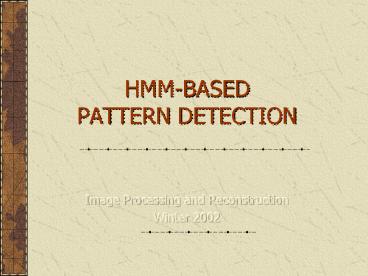HMM-BASED PATTERN DETECTION - PowerPoint PPT Presentation
1 / 14
Title:
HMM-BASED PATTERN DETECTION
Description:
HMM-BASED. PATTERN DETECTION. Image Processing and Reconstruction. Winter 2002. Outline ... Application: Pattern Detection. SNR=-5. SNR=10. Simulations ... – PowerPoint PPT presentation
Number of Views:99
Avg rating:3.0/5.0
Title: HMM-BASED PATTERN DETECTION
1
HMM-BASED PATTERN DETECTION
- Image Processing and Reconstruction
- Winter 2002
2
Outline
- Markov Process
- Hidden Markov Models
- Elements
- Basic Problems
- Evaluation
- Optimization
- Training
- Implementation
- 2-D HMM
- Application
- Simulation and Results
3
Markov Process
S2
- Can be described at any time to
- be in one state among N distinct
- states
- Its probabilistic description
- just requires a fixed specification
- of current and previous states
- actual state at time t
- state transition probability
- Each state corresponds to a physical (observable)
event - Too restrictive for sophisticated applications
S3
S1
a31
4
Extension to Hidden Markov Models
- A conditionally independent process on a Markov
chain - States correspond to clusters of context with
similar distribution - Elements of HMM
- State transition probability
- The observation symbol probability in each state
- The initial state distribution
5
Fundamental Problems for HMM
- Evaluation
- the probability of the observation OO1O2OT
given the model ?, P(O ?) - Optimization
- Choosing optimal state sequence given the
observation and the model ?. - Training
- Estimating model parameters to maximize P(O ?)
6
Evaluation the Model Forward-Backward Algorithm
- This calculation is on order of
- Forward-Backward Procedure with order of
- Forward variable
- Backward variable
7
Optimal States Sequence Solution(s)
- One solution choose the states which are
individually most likely. - This optimal solution has to be a valid state
sequence!! - Vitterbi Algorithm find the single best state
sequence that maximizes P(QO,?)
8
Training the Model
9
Continuous Observation Distributions
- In most of the applications (Speech, Image, ),
observations can not be characterized as discrete
symbols from finite alphabet and should be
considered by probability density function (PDF). - The most general representation of the PDF is a
finite mixture of normal distributions with
different means and variances for each state. - Estimating mean and variance instead of
estimating bj(k)
10
Implementation Considerations
- Scaling Dynamic range of ? and ? will exceed the
precision range of any machine - Multiple observations for training
- Initial Estimation of HMM Parameters
- for convergence, good initial values of PDF are
really helpful. - Choice of Model, Number of states, Choice of
observation PDF
11
Two-Dimensional HMM
- Set of Markovian states within each super-state
- Transition probability
- Useful for segmentation
Sub-State
Si-1,j
Si,j
Si,j-1
Super-State
12
Application Pattern Detection
- SNR-5
- SNR10
13
Simulations
- Feature Vector DCT Coefficients or their
averages over some of them - Block Size 1616
- Both images in training set and test set have
different rotation of jincs, but the distance
and center of them are fixed. - Running K-means Clustering Algorithm For initial
estimation - Comparing with template matching and Learning
Vector Quantization
Average of Absolute value of the Coefficients
14
Results and Conclusion!
- Detection Error































